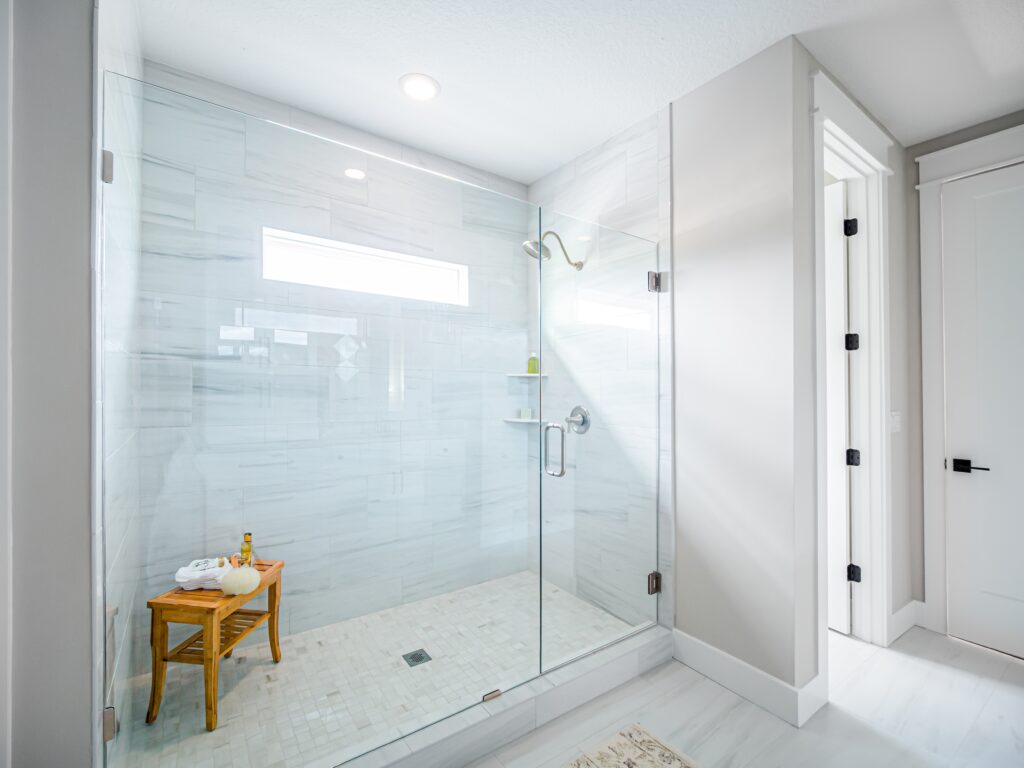Homeowner’s Guide for Tub to Shower Conversion

*Updated June 9th, 2025
Converting a bathtub into a shower is one of the most effective ways to modernize a bathroom and improve its functionality. With more homeowners prioritizing convenience, accessibility, and contemporary design, showers have become a preferred choice over traditional bathtubs. A well-executed tub-to-shower conversion not only saves space but also enhances safety and boosts the value of your home.
Whether you’re upgrading for everyday practicality or planning for aging in place, this guide covers all the essential details to help you achieve a seamless conversion.
Table of Contents
- Why Convert a Tub to a Shower?
- Types of Tub-to-Shower Conversions
- Cost Breakdown for a Tub-to-Shower Conversion
- Potential Add-On Costs
- Steps to Convert Your Bathtub to a Shower
- Popular Shower Design Ideas
- Things to Consider Before Starting Your Conversion
- Common Challenges and How to Overcome Them
- Tips for a Successful Tub-to-Shower Conversion
Why Convert a Tub to a Shower?
If your current bathroom feels outdated or no longer meets your needs, a tub-to-shower conversion could be the ideal solution.
Improved Accessibility
For homeowners with limited mobility or those planning to age in place, replacing a bathtub with a walk-in shower can greatly improve safety and accessibility. Features like grab bars, shower seats, and low-threshold entry allow for a safer bathing experience. Walk-in showers make it easy to slide in and out without the need to step over high tub walls.
Optimized Space
Bathtubs take up a large amount of room, making smaller bathrooms feel cramped and less functional. A shower conversion can open up your existing footprint and make the space appear larger, especially with features like frameless glass shower doors.
Modern Aesthetics
If your bath or shower feels outdated, a tub-to-shower conversion is a great way to transform your bathroom. Options like stylish tile walls, rainfall shower heads, and acrylic surrounds can give your space a brand-new look that fits your vision.
Increased Home Value
While homeowners often wonder if removing a bathtub will hurt resale value, this isn’t always the case. Many buyers prioritize functionality, and a modern shower area can appeal to those who value contemporary designs and mobility solutions. Keeping at least one bathtub in the home is often recommended for families with young children.
Types of Tub-to-Shower Conversions
When planning to convert your tub, you’ll want to choose between two primary options: prefabricated shower conversion kits and custom tiled showers.
Prefabricated Shower Units
Prefabricated shower units come as ready-to-install packages with shower walls, bases, and sometimes even doors. These are typically made of durable, easy-to-clean materials like acrylic or fiberglass.
Cost: Prefabricated units are more affordable, with prices ranging from $350 to $2,300 for materials alone.
Pros: Quick install, easy to clean, resistant to grout stains.
Cons: Limited customization, may not fit every existing tub footprint.
Custom Tiled Showers
For a premium look, consider a custom tiled walk-in shower. This allows you to create a completely unique bathroom shower tailored to your needs.
Cost: Custom tiled bathtub-to-shower conversions can cost between $3,500 and $15,000.
Pros: Fully customizable, higher resale value.
Cons: More expensive, requires more maintenance due to grout lines.
If you’re unsure which option is best, schedule a free consultation with a bathroom remodeling expert.
Cost Breakdown for a Tub-to-Shower Conversion
The cost of a tub conversion depends on materials, labor, and project complexity.
Average Costs
Standard tub-to-shower conversions range between $1,500 and $8,000. Custom upgrades can exceed $15,000.
Factors That Affect Conversion Cost
- Materials: From conversion kits to luxury tile, the choices can vary widely.
- Labor: Hiring a professional installer will raise costs but ensure quality.
- Plumbing Adjustments: Rerouting pipes or updating fixtures adds to the price.
- Demolition and Disposal: Removing your existing tub and hauling it off has a cost too.
- Additional Features: Think rain showers, glass doors, built-in seats, or grab bars.
Potential Add-On Costs
Waterproofing and Drainage
Proper waterproofing protects against water damage and ensures the conversion lasts.
- Use waterproof membranes beneath shower tiles
- Upgrade drains for better flow
Permits
Significant plumbing changes may require permits. A licensed plumber can ensure compliance.
Custom Glass Doors
Elevate your new shower with frameless or sliding glass doors.
Accessibility Upgrades
- Non-slip shower base
- Built-in or foldable seats
- Grab bars for safety
Steps to Convert Your Bathtub to a Shower
- Planning & Design – Choose layout, materials, and fixtures.
- Remove Existing Tub – Demo, disconnect plumbing, assess for mold or rot.
- Plumbing Adjustments – Reroute pipes or update hardware.
- Install Shower Base – Prefab or tiled.
- Install Walls & Surrounds – Choose acrylic or tile.
- Final Touches – Install fixtures, glass doors, and seating.
Popular Shower Design Ideas
- Walk-in shower with frameless glass
- Recessed niches or corner shelving
- Premium shower heads like rainfall or handheld sprayers
- Sleek acrylic surrounds or bold tile designs
Things to Consider Before Starting Your Conversion
- Plumbing and Structural Checks
- Local remodel permits
- Resale considerations—keep at least one bathtub if possible
- DIY vs. professional installation—especially with plumbing and waterproofing
Common Challenges and How to Overcome Them
Hidden Water Damage
Old tubs may hide mold or rot. Proper inspection and prep are key.
Budget Overruns
Always add 10–15% for unexpected costs—like extra plumbing systems or shower base issues.
Outdated Plumbing
Old homes may need upgraded pipes to support a new bath or shower.
Tips for a Successful Tub-to-Shower Conversion
- Hire licensed bathroom remodeling experts
- Use low-maintenance materials like acrylic
- Add accessibility features for future-proofing
- Waterproof thoroughly
- Explore financing options to manage your bathtub conversion budget
FAQs
How long does a tub-to-shower conversion take?
Anywhere from 2 to 5 days, depending on whether you’re using a conversion kit or custom tile work.
Can I do the conversion myself?
DIY is possible with a shower conversion kit, but most homeowners opt for a professional installer for safety and quality.
Can I keep my existing plumbing fixtures?
Yes—if they’re compatible. However, many choose to upgrade to modern shower heads for better performance.
Will this hurt resale value?
Not if you keep at least one bathtub in the house. A well-designed walk-in shower often increases value.
What are the best materials for a low-maintenance shower?
Acrylic and fiberglass are great options. For a higher-end look with less scrubbing, use large-format tile to reduce grout lines.a more functional space, this renovation offers countless benefits. For a smooth installation, consult with a professional contractor and start planning your dream shower today.
Sources
Additional Bathroom Remodel Resources
- 14 Bathroom Remodel Ideas
- Bathroom Remodel ROI – What Can You Expect?
- How to Get Rid of Bathroom Mold

Anna has over six years of experience in the home services and journalism industries and serves as the Content Manager at MyHomePros.com, specializing in making complex home improvement topics like HVAC, roofing, and plumbing accessible to all. With a bachelor’s degree in journalism from Auburn University, she excels in crafting localized, comprehensive guides that cater to homeowners’ unique needs. Living on both coasts of the United States has equipped her with a distinctive perspective, fueling her passion for turning any house into a cherished home through informed, personalized decision-making.








